How To Upload Data Into Stata
In this mail, we are going to larn how to read Stata (.dta) files in R statistical environs. Specifically, we will learn i) how to read .dta files in R using Haven, and 2) how to write dataframes to .dta file.
Data Import in R: Reading Stata Files
Now, R is, as we all know, a superb statistical programming environment. When information technology comes to importing and storing information, we can store our data in the native .rda format. Withal, if we take a collaborator that uses other statistical software (due east.g., Stata) and/or that are storing their information in different formats (e.g., .dta files).
At present, this is when R shows usa its brilliance; as an R user we can load data from a range of file formats; due east.g., SAS (.7bdat), Stata (.dta), Excel (e.g., .xlsx), and CSV (.csv). On this site there are other tutorials on how to import information from (some) of these formats:
- How to Import SAS files in R
- Reading and writing SPSS files in R
- How to read, and write, Excel (.xslx) files in R – eastward.yard., multiple sheets
Earlier we become on and learn how to read Stata files in R, we will respond the questions:
Can R Read Stata .dta Files?
The answer is "yeah!, R tin read Stata (.dta) files. This is easy to do with the Oasis package. First, load the package: library(haven). Second, utilise the read_dta() function.
How do I open up a Stata file in R
To open a Stata file in R you can employ the read_dta() function from the library called haven. For instance, study_df <- read_dta('study_data.dta') will open the Stata file called "study_data.dta" and create a data frame object.
How to Read dta File in R
At present, we are soon ready to answer how to open a Stata file in R? by using easy to follow examples. In R, there are many useful packages that make information technology possible for us to open .dta files. Here, in this tutorial, notwithstanding, we are going to use the packet Haven (which is part of the Tidyverse package).
Install Haven:
First, the library need to be installed. Haven tin can be installed separately or by installing the Tidyverse packages. Beginning, if we want to only haven we open up R (or RStudio) and type install.packages("haven"). If nosotros, on the other manus, want to install all Tidyverse packages we change "haven" to "tidyverse": install.packages('tidyverse').
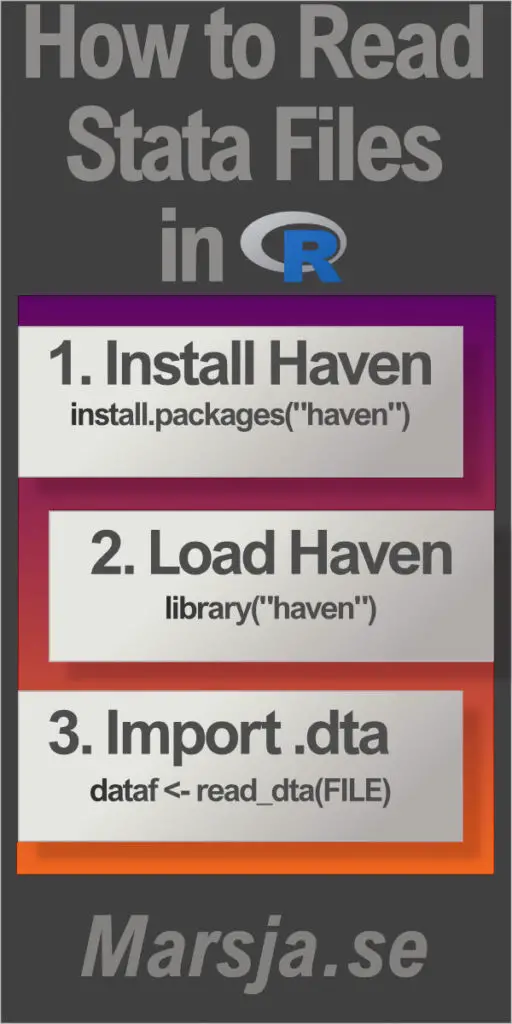
- Learn how to add a column to a dataframe in R based on other columns.
The Syntax of read_dta()
In this department, before learning the steps to reading a .dta file, we will have a quick wait at the syntax of the read_dta() function. In it's simples class here'southward how to import information from a .dta file in R:
# import dta file in r dataframe <- read_dta('PATH_OR_URL_TO_STATA_FILE')
Code language: PHP ( php ) Of course, the function comes packed with a couple of arguments:
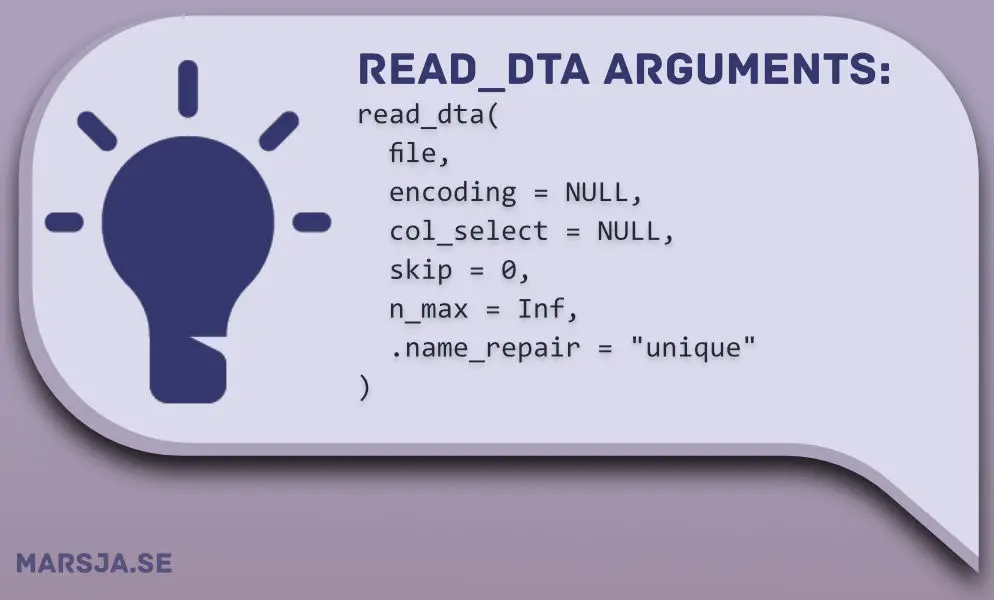
As you lot tin can see, the first argument is the file, which should be the path, or URL, to the file. This is axiomatic from the syntax to a higher place, also. In this tutorial, we volition have a await at the col_select argument.
How to Read a dta File in R Step-Past-Step
In this section, we are finally going to learn how to import .dta files in R. Here are the three uncomplicated steps to read a Stata file in R:
i) Load the haven Library:
First, nosotros are going to load the Oasis packet: library(haven). Now that we have all the functions of the Haven parcel in the namespace we can continue to step two: finding the .dta file nosotros want to read.
2) Detect the .dta File
2nd, earlier we can import the Stata file, we need to know where the file is located. In the side by side pace we, therefore, create a grapheme variable with the path to the file.
dtafile <- file.path(getwd(), "RScripts", "Data", "FifthDayData.dta")
Code language: R ( r ) Note, in the read_dta() instance higher up, the r-script and the data file is in two subfolders (i.e., Data is a subfolder of the script). To elaborate, we used the getwd() function to become the current working directory (e.g., "C:/Users/Erik/Documents"). Moreover, the .dta file is located in the subfolder (due east.grand., "Information") to the "RScripts" binder. Thus, the next two graphic symbol vectors are indicating where the file is and, finally, nosotros have the file name.
3) Read the File using read_dta():
Now, we are ready to actually import the data, from our .dta file, into R. This is washed using the read_dta() role, every bit previously mentioned. Hither's how to read a dta file in R:
# import dta file in r fifthD.df <- read_dta(dtafile) caput(fifthD.df)
Code language: R ( r ) 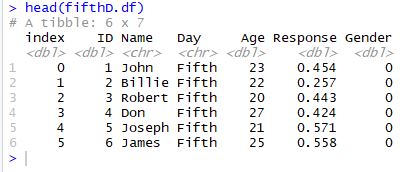
That was information technology, you have now read the .dta files into a dataframe. Next, you may want to conduct out uncomplicated data manipulation e.g., add empty column to dataframe in R.
How to a Read .dta File in R from a URL
In this section, we are going to learn how to import a Stata file (.dta) from a URL. This is, of form, as elementary as loading the data from the hard bulldoze. Naturally, however, we demand to modify the character variable. Here'southward an instance on how to read a dta file from a URL:
url <- "http://www.principlesofeconometrics.com/stata/broiler.dta" data.df <- read_dta(dtafile) head(data.df)
Code language: R ( r ) 
If your data includes datetime, and you want to divide time from date, check the latest post:
- How to Extract Time from Datetime in R – with Examples
How to Read Specific Columns from a Stata (.dta) file in R
In this section, of the read Stata files in R tutorial, we are going to learn how to utilise read_dta() to load specific columns. This may be useful when we plan to analyze some specific variables from very large datasets.
Reading Ane Column from a dta File in R
First, we are going to read only one column. In the code chunk below, we are reading the "pbeef" cavalcade. Thus, we are using the col_select argument and use a character that is specifying the column we want to read:
data.df <- read_dta(url, col_select="pbeef") head(data.df))
Code language: R ( r ) Reading Multiple Columns from a dta File in R
Now, if we desire to read many columns from the .dta file we'll first create a character vectors with the column names:
cols <- c("pbeef")
Code language: R ( r ) Finally, we are ready to read the columns. Notation, here we utilize the all_of function:
Code language: R ( r )
information.df <- read_dta(url, col_select=all_of(cols)) head(information.df))
We have now learned how to read a Stata file in R, the next stride might be to inspect the dataframe, visualize the data, and if we have categorical information nosotros should dummy lawmaking them. Meet the posts on how to create scatter plots in R with ggplot2 and how to create dummy variables in R.
How to Salvage a Stata file
In this department, nosotros will larn how to write a dataframe to a Stata file. Kickoff, nosotros will larn how to do some data manipulation on a .dta file nosotros have loaded in R and save it as a new .dta file. 2nd, we are going to learn how to read an Excel file in R and salve it as a Stata file.
Saving a dataframe as a Stata file using write_dta()
In the example below, nosotros are first going to load a .dta file using read_dta(). Second, we are going to remove columns in R using dplyr(). Finally, when we take deleted the columns we don't want, we are going to save the dataframe as a .dta file.
library(oasis);library(dplyr) ## Dta file: dtafile <- file.path(getwd(), "RScripts", "Data", "FifthDayData.dta") dta.df <- read_dta(dtafile)
Code language: R ( r ) In the code chunk, above, nosotros did not do anything new (for this post). Now, in the side by side lawmaking chunk, nosotros are deleting two columns.
Code language: R ( r )
newdta.df <- select(dta.df, -c(index, Twenty-four hours))
Finally, we are ready to write the dataframe equally a .dta file:
write_dta(newdta.df, file.path(getwd(), "RScripts", "Data", "NewFifthDayData.dta"))
Code language: R ( r ) 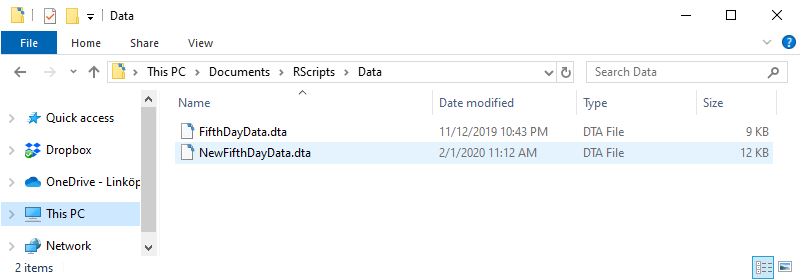
Annotation, before saving your dta file yous might want to employ R to remove duplicate rows and columns from the data frame. This can be done either using the functions duplicated() or unique().
Salve a CSV file as a Stata File
In this section, we are going to piece of work with another R package, from the tidyverse package; readr. Now, we are going to apply the read_csv to read data from a CSV file. After we accept imported the CSV to a dataframe we are going to save it as a .dta file using Haven's write_dta() part:
library(readr) csvfile <- file.path(getwd(), "RScripts", "Data", "FirstDayData.csv") data.df <- read_csv(csvfile) View(data.df) ## Saving information technology as a dta write_dta(data.df, file.path(getwd(), "RScripts", "Data", "FirstDayData.dta"))
Code language: R ( r ) 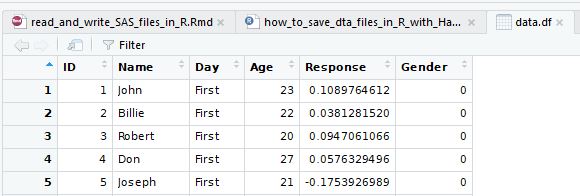
Export an Excel file as a Stata File
In the concluding instance, we are going to use read_excel (from the readxl packet) to import a .xslx file in R. Later on we take done that, we will relieve this Excel file as a Stata file.
library(readxl) xlfile <- file.path(getwd(), "RScripts", "Data", "example_concat.xlsx") data.df <- read_excel(xlfile) write_dta(data.df, file.path(getwd(), "RScripts", "Information", "STATADATA.dta"))</code></pre>
Code language: R ( r ) Notation, all the files we have read using read_dta, read_stata, read_csv, and read_excel can be constitute here and a Jupyter notebook tin can be constitute hither.
Summary: Read Stata Files using R
In this post, we have learned how to read Stata files in R. Specifically, we've learned how to load .dta files using the Haven package. Furthermore, nosotros accept learned how to write R dataframes to Stata files, as well every bit loading information from Excel and CSV files to save them as .dta files.
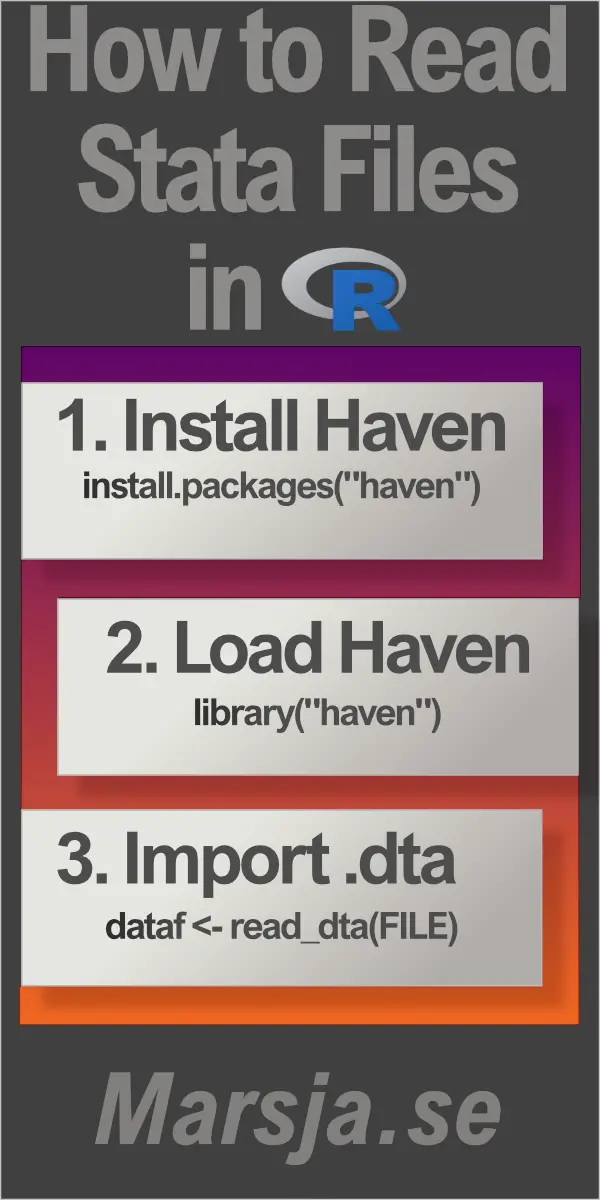
Source: https://www.marsja.se/how-to-read-and-write-stata-dta-files-in-r-with-haven/
Posted by: kinghossing.blogspot.com


0 Response to "How To Upload Data Into Stata"
Post a Comment